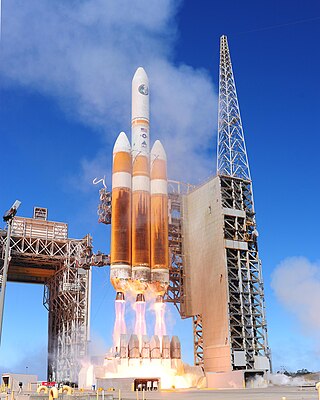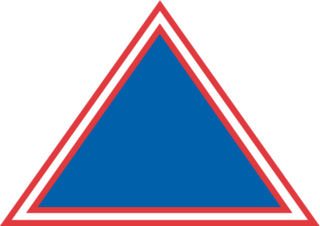
The Burner, Burner II, and Burner IIA rocket stages have been used as upper stages of launch vehicles such as the Thor-Burner and Delta since 1965.

The Burner, Burner II, and Burner IIA rocket stages have been used as upper stages of launch vehicles such as the Thor-Burner and Delta since 1965.
The Burner I stage (also called the Altair stage) was derived from the fourth stage of the Scout launch vehicle, and was powered by a Star 37 solid rocket motor (Thiokol TE 364-1). [1] [2]
In September 1965, Air Force Space Systems Division announced the development of a new, low cost upper stage called Burner II, powered by Thiokol TE-M-364-2 engine. [2] . It was intended as the smallest maneuverable upper stage in the Air Force inventory. In June 1967, the first Thor/Burner II vehicle successfully launched a pair of satellites to orbit.
In June 1971, the last of the Burner II missions was launched from Vandenberg by a Thor/Burner II launch vehicle and carried an SESP-1 space environmental satellite. [3]
In the mid-1970s Burner II was also studied for use as an upper stage in combination with the Space Shuttle. NASA managers choose other solutions for missions where upper stages were required. [4]
In June 1969, the Space and Missile Systems Organization (SAMSO) began development of the Burner IIA configuration which would offer a tandem motor injection capability and almost twice the capability of Burner II. [5]
In addition to use on Delta family rockets, Burner II stages have been used on both Atlas and Titan rockets. [6] Atlas E/F vehicles were configured with a Burner II/IIA stage and launched in 1968 and 1972. The first launch failed with the second delivering a radiation research payload for the Space Test Program (P72-1 Radsat) using Burner IIA. [7]

A solid-propellant rocket or solid rocket is a rocket with a rocket engine that uses solid propellants (fuel/oxidizer). The earliest rockets were solid-fuel rockets powered by gunpowder; The inception of gunpowder rockets in warfare can be credited to the ancient Chinese, and in the 13th century, the Mongols played a pivotal role in facilitating their westward adoption.

An expendable launch system is a launch vehicle that can be launched only once, after which its components are either destroyed during reentry or discarded in space. ELVs typically consist of several rocket stages that are discarded sequentially as their fuel is exhausted and the vehicle gains altitude and speed. As of 2024, fewer and fewer satellites and human spacecraft are launched on ELVs in favor of reusable launch vehicles. However, there are many instances where a ELV may still have a compelling use case over a reusable vehicle. ELVs are simpler in design than reusable launch systems and therefore may have a lower production cost. Furthermore, an ELV can use its entire fuel supply to accelerate its payload, offering greater payloads. ELVs are proven technology in widespread use for many decades.

The RM-81 Agena was an American rocket upper stage and satellite bus which was developed by Lockheed Corporation initially for the canceled WS-117L reconnaissance satellite program. Following the division of WS-117L into SAMOS and Corona for image intelligence, and MIDAS for early warning, the Agena was later used as an upper stage, and an integrated component, for several programs, including Corona reconnaissance satellites and the Agena Target Vehicle used to demonstrate rendezvous and docking during Project Gemini. It was used as an upper stage on the Atlas, Thor, Thorad and Titan IIIB rockets, and considered for others including the Space Shuttle and Atlas V. A total of 365 Agena rockets were launched between February 28, 1959 and February 1987. Only 33 Agenas carried NASA payloads and the vast majority were for DoD programs.

Delta II was an expendable launch system, originally designed and built by McDonnell Douglas, and sometimes known as the Thorad Delta 1. Delta II was part of the Delta rocket family, derived directly from the Delta 3000, and entered service in 1989. There were two main variants, the Delta 6000 and Delta 7000, with the latter also having "Light" and "Heavy" subvariants. During its career, Delta II flew several notable payloads, including 24 Global Positioning System (GPS) Block II satellites, several dozen NASA payloads, and 60 Iridium communication satellites. The rocket flew its final mission, ICESat-2, on 15 September 2018, earning the launch vehicle a streak of 100 successful missions in a row, with the last failure being GPS IIR-1 in 1997. In the late 1990s, Delta II was developed further into the unsuccessful Delta III, which was in turn developed into the more capable and successful Delta IV, though the latter shares little heritage with the original Thor and Delta rockets.

The Delta rocket family was a versatile range of American rocket-powered expendable launch systems that provided space launch capability in the United States from 1960 to 2024. Japan also launched license-built derivatives from 1975 to 1992. More than 300 Delta rockets were launched with a 95% success rate. The series was phased out in favor of the Vulcan Centaur, with the Delta IV Heavy rocket's last launch occurring on April 9, 2024.

Delta IV was a group of five expendable launch systems in the Delta rocket family. It flew 45 missions from 2002 to 2024. Originally designed by Boeing's Defense, Space and Security division for the Evolved Expendable Launch Vehicle (EELV) program, the Delta IV became a United Launch Alliance (ULA) product in 2006. The Delta IV was primarily a launch vehicle for United States Air Force (USAF) military payloads, but was also used to launch a number of United States government non-military payloads and a single commercial satellite.

Atlas II was a member of the Atlas family of launch vehicles, which evolved from the successful Atlas missile program of the 1950s. The Atlas II was a direct evolution of the Atlas I, featuring longer first-stage tanks, higher-performing engines, and the option for strap-on solid rocket boosters. It was designed to launch payloads into low Earth orbit, geosynchronous transfer orbit or geosynchronous orbit. Sixty-three launches of the Atlas II, IIA and IIAS models were carried out between 1991 and 2004; all sixty-three launches were successes, making the Atlas II a highly reliable space launch system. The Atlas line was continued by the Atlas III, used between 2000 and 2005, and the Atlas V, which is still in use as of 2024.

The Scout family of rockets were American launch vehicles designed to place small satellites into orbit around the Earth. The Scout multistage rocket was the first orbital launch vehicle to be entirely composed of solid fuel stages. It was also the only vehicle of that type until the successful launch of the Japanese Lambda 4S in 1970.
Thiokol was an American corporation concerned initially with rubber and related chemicals, and later with rocket and missile propulsion systems. Its name is a portmanteau of the Greek words for sulfur and glue, an allusion to the company's initial product, Thiokol polymer.

The Payload Assist Module (PAM) is a modular upper stage designed and built by McDonnell Douglas (Boeing), using Thiokol Star-series solid propellant rocket motors. The PAM was used with the Space Shuttle, Delta, and Titan launchers and carried satellites from low Earth orbit to a geostationary transfer orbit or an interplanetary course. The payload was spin stabilized by being mounted on a rotating plate. Originally developed for the Space Shuttle, different versions of the PAM were developed:

The Star 48 is the largest of a family of solid rocket motors used by many space propulsion and launch vehicle stages, almost exclusively as an upper stage. It was developed primarily by Thiokol Propulsion and after several mergers, is manufactured by Northrop Grumman’s Space Systems division. A Star 48B stage is also one of the few man-made items sent on escape trajectories out of the Solar System, although it is derelict since its use. The Star 48B variant was the PAM-D upper stage used on the retired Delta II rocket.

Castor is a family of solid-fuel rocket stages and boosters built by Thiokol and used on a variety of launch vehicles. They were initially developed as the second-stage motor of the Scout rocket. The design was based on the MGM-29 Sergeant, a surface-to-surface missile developed for the United States Army at the Jet Propulsion Laboratory.

Space Systems Command (SSC) is the United States Space Force's space development, acquisition, launch, and logistics field command. It is headquartered at Los Angeles Air Force Base, California, and manages the United States' space launch ranges.
Thor was a US space launch vehicle derived from the PGM-17 Thor intermediate-range ballistic missile. The Thor rocket was the first member of the Delta rocket family of space launch vehicles. The last launch of a direct derivative of the Thor missile occurred in 2018 as the first stage of the final Delta II.
The Thor-Burner was an American expendable launch system, a member of the Thor rocket family. It consisted of a Thor missile, with one or two Burner upper stages. It was used between 1965 and 1976 to orbit a number of satellites, most commonly Defense Meteorological Satellite Program (DMSP) weather satellites. Twenty-four were launched, of which two failed. It weighed 51,810 kg and was 24 metres tall.

The Altair was a solid-fuel rocket with a fiberglass casing, initially developed for use as the third stage of Vanguard rockets in 1959. It was manufactured by Allegany Ballistics Laboratory (ABL) as the X-248. It was also sometimes called the Burner 1.

The 6555th Aerospace Test Group is an inactive United States Air Force unit. It was last assigned to the Eastern Space and Missile Center and stationed at Patrick Air Force Base, Florida. It was inactivated on 1 October 1990.
The Star is a family of US solid-propellant rocket motors originally developed by Thiokol and used by many space propulsion and launch vehicle stages. They are used almost exclusively as an upper stage, often as an apogee kick motor. The number designations refer to the approximate diameter of the fuel casing in inches.

Orbital ATK Inc. was an American aerospace manufacturer and defense industry company. It was formed in February 9, 2015 from the merger of Orbital Sciences Corporation and parts of Alliant Techsystems (ATK). Orbital ATK designed, built, and delivered rocket engines, military vehicles, firearms, autocannons, missiles, ammunition, precision-guided munitions, satellites, missile approach warning systems, launch vehicles and spacecraft. The company was acquired by Northrop Grumman on June 6, 2018. The former Orbital ATK operations were renamed Northrop Grumman Innovation Systems and operated as a division until January 1, 2020 when a reorganization merged the operations into the company's other divisions.